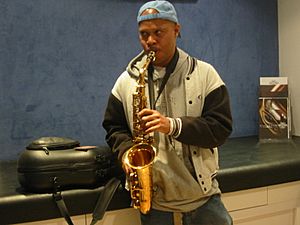Steve Coleman facts for kids
Quick facts for kids
Steve Coleman
|
|
|---|---|

Steve Coleman in Paris, July 2004
|
|
| Background information | |
| Birth name | Steven Douglas Coleman |
| Born | September 20, 1956 Chicago, Illinois, U.S. |
| Genres | Jazz, avant-garde, M-Base |
| Occupation(s) | Musician, composer, bandleader |
| Instruments | Saxophone |
| Labels | JMT, Pangaea, Novus, BMG, Label Bleu, Pi |
| Associated acts | Five Elements, M-Base Collective, Strata Institute |
Steve Coleman (born September 20, 1956) is an American musician. He plays the saxophone, writes music, and leads bands. He is also known for his ideas about music theory. In 2014, he received a special award called a MacArthur Fellowship. This award recognizes very talented people.
Contents
Early Life and Musical Journey
Steve Coleman grew up in South Side, Chicago. He started playing the alto saxophone when he was 14 years old. He went to college for two years before moving to New York City in 1978.
In New York, Steve played with many big bands. He also worked with famous musicians like David Murray and Abbey Lincoln. For his first four years in New York, Steve played music on the streets and in small clubs. He formed a band with trumpeter Graham Haynes. This group later became known as Steve Coleman and Five Elements. In this band, he developed his unique way of improvising music. Steve also worked with other young African-American musicians. Together, they started a music movement called M-Base.
Exploring Music and Cultures
Steve Coleman believes that his music comes from African traditions. He wanted to learn more about these roots. So, in 1993, he traveled to Ghana in Africa. There, he met the Dagomba people. They play drum music with complex rhythms. They can even "speak" through their drums! This made Steve think about how music shares information in different cultures.
He wanted to work with musicians from West Africa. He was very interested in the Yoruba tradition. This is an ancient African religion. It is also part of traditions like Santería in Cuba and Candomblé in Brazil.
In Cuba, Steve found a group called Afrocuba de Matanzas. This group keeps old Cuban music styles alive. In 1996, Steve and his musicians worked with Afrocuba de Matanzas. They performed at the Havana Jazz Festival. They also recorded an album called The Sign and the Seal. In 1997, Steve took musicians from America and Cuba to Senegal. They shared music and culture with a local group there. He also visited India in 1998. There, he learned about carnatic music.
In September 2014, Steve Coleman received the MacArthur Fellowship. This award recognized his fresh and new approach to jazz music.
Steve Coleman's Albums
Steve Coleman has released many albums as a bandleader. Here are some of his main works:
- Motherland Pulse (1985)
- On the Edge of Tomorrow (1986)
- World Expansion (1987)
- Sine Die (1988)
- Rhythm People (The Resurrection of Creative Black Civilization) (1990)
- Black Science (1991)
- Phase Space with Dave Holland (1991)
- Drop Kick (1992)
- Rhythm in Mind (1992)
- The Tao of Mad Phat (1993)
- We Beez Like That! (1995)
- Myths, Modes and Means (1995)
- The Way of the Cipher (1995)
- Def Trance Beat (1995)
- Curves of Life (1995)
- Steve Coleman's Music: Live in Paris (1995)
- The Sign and the Seal (1996)
- Genesis & the Opening of the Way (1997)
- The Sonic Language of Myth (1999)
- The Ascension to Light (2001)
- Resistance Is Futile (2001)
- On the Rising of the 64 Paths (2002)
- Lucidarium (2004)
- Weaving Symbolics (2006)
- Invisible Paths: First Scattering (2007)
- Harvesting Semblances and Affinities (2010)
- The Mancy of Sound (2011)
- Functional Arrhythmias (2013)
- Synovial Joints (2015)
- Morphogenesis (2017)
- Live at the Village Vanguard Vol. I (The Embedded Sets) (2018)
- Live at the Village Vanguard Vol. II (MDW NTR) (2021)
- PolyTropos / Of Many Turns (2024)
See also
 In Spanish: Steve Coleman para niños
In Spanish: Steve Coleman para niños

